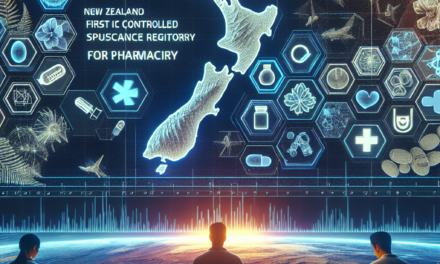Revolutionizing Eye Care: EHNOTE’s Impact at ASCRS-ASOA 2025 with Ophthalmology 2.0
The field of ophthalmology is undergoing a significant transformation, driven by technological advancements and innovative approaches to patient care. At the forefront of this revolution is EHNOTE, a pioneering company that is reshaping the landscape of eye care. Their participation in the ASCRS-ASOA 2025 conference highlights the importance of integrating technology into ophthalmology, marking the dawn of what is being termed “Ophthalmology 2.0.” This article delves into the multifaceted impact of EHNOTE on eye care, exploring five key areas: the evolution of telemedicine, the integration of artificial intelligence, patient engagement strategies, data management and analytics, and the future of surgical techniques.
The Evolution of Telemedicine in Ophthalmology
Telemedicine has emerged as a game-changer in healthcare, and ophthalmology is no exception. The COVID-19 pandemic accelerated the adoption of telehealth services, allowing patients to receive care from the comfort of their homes. EHNOTE has been at the forefront of this shift, providing innovative solutions that enhance remote eye care.
Telemedicine in ophthalmology encompasses a range of services, including virtual consultations, remote monitoring, and digital diagnostics. EHNOTE’s platform enables ophthalmologists to conduct comprehensive eye exams remotely, utilizing advanced imaging technologies and secure communication channels. This not only improves access to care for patients in rural or underserved areas but also streamlines the workflow for healthcare providers.
- Accessibility: Telemedicine breaks down geographical barriers, allowing patients to connect with specialists regardless of their location. This is particularly beneficial for individuals with mobility issues or those living in remote areas.
- Cost-Effectiveness: Virtual consultations reduce the need for in-person visits, lowering transportation costs and minimizing time off work for patients.
- Continuity of Care: Telemedicine facilitates ongoing monitoring of chronic eye conditions, enabling timely interventions and reducing the risk of complications.
Case studies have shown that telemedicine can significantly improve patient outcomes. For instance, a study published in the journal “Ophthalmology” found that patients with diabetic retinopathy who received telehealth consultations had a 30% higher adherence rate to follow-up appointments compared to those who relied solely on in-person visits. EHNOTE’s platform has been instrumental in achieving such results, providing tools that enhance communication between patients and providers.
Moreover, the integration of telemedicine into ophthalmology has led to the development of specialized training programs for healthcare professionals. EHNOTE offers resources and workshops to help ophthalmologists adapt to this new model of care, ensuring they are equipped with the necessary skills to deliver high-quality virtual consultations.
Artificial Intelligence: Transforming Diagnostics and Treatment
Artificial intelligence (AI) is revolutionizing various sectors, and ophthalmology is no exception. EHNOTE is leveraging AI technologies to enhance diagnostic accuracy and treatment efficacy. By analyzing vast amounts of data, AI algorithms can identify patterns and anomalies that may be missed by the human eye.
One of the most significant applications of AI in ophthalmology is in the early detection of eye diseases. For example, EHNOTE’s AI-powered diagnostic tools can analyze retinal images to detect conditions such as glaucoma, diabetic retinopathy, and age-related macular degeneration at their earliest stages. This early detection is crucial, as it allows for timely intervention and can significantly reduce the risk of vision loss.
- Enhanced Diagnostic Accuracy: AI algorithms can process images with remarkable precision, often outperforming human specialists in identifying subtle changes in retinal structures.
- Predictive Analytics: By analyzing patient data, AI can predict the likelihood of disease progression, enabling ophthalmologists to tailor treatment plans to individual patients.
- Streamlined Workflow: AI can automate routine tasks, such as image analysis and data entry, allowing healthcare providers to focus on patient care.
Case studies have demonstrated the effectiveness of AI in improving patient outcomes. A study conducted by researchers at Stanford University found that an AI system developed for detecting diabetic retinopathy achieved an accuracy rate of 94.6%, surpassing that of human ophthalmologists. EHNOTE’s commitment to integrating AI into their services is paving the way for a new era of precision medicine in eye care.
Furthermore, EHNOTE is actively involved in research collaborations aimed at advancing AI technologies in ophthalmology. By partnering with academic institutions and technology companies, they are at the forefront of developing innovative solutions that will shape the future of eye care.
Patient Engagement Strategies: Empowering Individuals in Their Eye Care Journey
Patient engagement is a critical component of effective healthcare, and EHNOTE recognizes the importance of empowering individuals to take an active role in their eye care. By providing patients with the tools and resources they need, EHNOTE is fostering a culture of collaboration between patients and healthcare providers.
One of the key strategies employed by EHNOTE is the development of user-friendly mobile applications that allow patients to track their eye health, schedule appointments, and access educational resources. These applications serve as a bridge between patients and their ophthalmologists, facilitating communication and enhancing the overall patient experience.
- Education and Awareness: EHNOTE’s platforms provide patients with valuable information about eye health, treatment options, and preventive measures, empowering them to make informed decisions.
- Personalized Care Plans: By involving patients in the development of their care plans, EHNOTE ensures that treatment strategies align with individual preferences and lifestyles.
- Feedback Mechanisms: EHNOTE encourages patients to provide feedback on their experiences, allowing healthcare providers to continuously improve their services.
Research has shown that engaged patients are more likely to adhere to treatment plans and attend follow-up appointments. A study published in the “Journal of Medical Internet Research” found that patients who used mobile health applications reported higher levels of satisfaction with their care and were more likely to engage in preventive health behaviors. EHNOTE’s commitment to patient engagement is not only improving individual outcomes but also contributing to the overall efficiency of the healthcare system.
Moreover, EHNOTE is exploring innovative ways to enhance patient engagement through gamification and social support networks. By incorporating elements of game design into their applications, they aim to motivate patients to take an active role in managing their eye health.
Data Management and Analytics: Harnessing Information for Better Outcomes
In the digital age, data is a valuable asset, and EHNOTE is harnessing the power of data management and analytics to improve eye care outcomes. By collecting and analyzing patient data, EHNOTE can identify trends, monitor treatment effectiveness, and enhance clinical decision-making.
EHNOTE’s data management platform integrates information from various sources, including electronic health records, imaging systems, and patient-reported outcomes. This comprehensive approach allows ophthalmologists to gain a holistic view of each patient’s health, enabling more informed treatment decisions.
- Real-Time Monitoring: EHNOTE’s analytics tools enable healthcare providers to monitor patient progress in real-time, facilitating timely interventions when necessary.
- Population Health Management: By analyzing data across patient populations, EHNOTE can identify at-risk groups and implement targeted interventions to improve overall health outcomes.
- Research and Development: The insights gained from data analytics can inform research initiatives, leading to the development of new treatment protocols and technologies.
Case studies have highlighted the impact of data analytics on patient care. For instance, a study conducted by the American Academy of Ophthalmology found that practices utilizing data analytics tools experienced a 20% reduction in hospital readmissions for eye-related conditions. EHNOTE’s commitment to data-driven decision-making is positioning them as leaders in the field of ophthalmology.
Furthermore, EHNOTE is dedicated to ensuring the security and privacy of patient data. By implementing robust cybersecurity measures and adhering to regulatory standards, they are building trust with patients and healthcare providers alike.
The Future of Surgical Techniques: Innovations in Ophthalmology
The field of ophthalmic surgery is rapidly evolving, with new techniques and technologies emerging to enhance surgical outcomes. EHNOTE is at the forefront of this revolution, exploring innovative approaches that are transforming the way eye surgeries are performed.
One of the most exciting developments in ophthalmic surgery is the use of minimally invasive techniques. EHNOTE is actively researching and promoting procedures that reduce recovery times and improve patient comfort. For example, advancements in laser technology have enabled surgeons to perform cataract surgeries with greater precision and less trauma to surrounding tissues.
- Robotic-Assisted Surgery: EHNOTE is exploring the use of robotic systems in ophthalmic procedures, which can enhance precision and reduce the risk of complications.
- Augmented Reality: The integration of augmented reality into surgical planning and execution is providing surgeons with enhanced visualization, leading to improved outcomes.
- Personalized Surgical Approaches: By utilizing data analytics and AI, EHNOTE is developing personalized surgical plans that take into account individual patient characteristics and preferences.
Case studies have demonstrated the effectiveness of these innovative surgical techniques. A study published in “Ophthalmology” found that patients who underwent robotic-assisted cataract surgery experienced shorter recovery times and fewer complications compared to traditional methods. EHNOTE’s commitment to advancing surgical techniques is not only improving patient outcomes but also setting new standards in the field of ophthalmology.
As EHNOTE continues to push the boundaries of what is possible in eye care, they are also investing in training and education for ophthalmic surgeons. By providing access to the latest technologies and techniques, they are ensuring that healthcare providers are equipped to deliver the highest quality of care.
Conclusion: A New Era in Eye Care
EHNOTE’s impact at ASCRS-ASOA 2025 is a testament to the transformative power of technology in ophthalmology. Through their innovative approaches to telemedicine, artificial intelligence, patient engagement, data management, and surgical techniques, EHNOTE is revolutionizing eye care and setting new standards for the future.
The integration of these advancements not only enhances patient outcomes but also improves the overall efficiency of the healthcare system. As we move towards Ophthalmology 2.0, it is clear that EHNOTE is leading the charge in redefining how eye care is delivered and experienced.
In summary, the key takeaways from this exploration of EHNOTE’s impact include:
- The evolution of telemedicine is improving access to eye care, particularly for underserved populations.
- Artificial intelligence is enhancing diagnostic accuracy and enabling personalized treatment plans.
- Patient engagement strategies are empowering individuals to take an active role in their eye health.
- Data management and analytics are driving informed decision-making and improving population health outcomes.
- Innovations in surgical techniques are transforming ophthalmic procedures, leading to better patient experiences and outcomes.
As we look to the future, it is evident that EHNOTE will continue to play a pivotal role in shaping the landscape of eye care, ensuring that patients receive the highest quality of care in an increasingly digital world.





